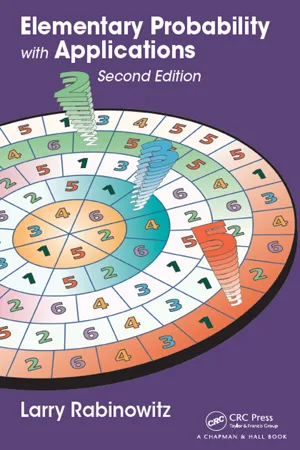1.1 Sample Spaces, Events, and Probabilities
A sample space, S, is defined as the set of all possible outcomes of an experiment. If the outcomes in S are equally likely, we call S an equally probable sample space. Any subset of S is called an event. For example, if a box contains three chips numbered 1,2,3 and we draw one chip from the box in such a way that each of the three chips is equally likely to be selected, then {1,2,3} is an equally probable sample space and ϕ(empty set), {1}, {2}, {3}, {1,2}, {1,3}, {2,3}, {1,2,3} are events. For this experiment {odd, even} is also a sample space but it is not an equally probable sample space since an odd outcome is twice as likely as an even outcome.
Let P(A) denote the probability that event A will occur. If S is an equally probable sample space, then
Example 1.1. Box I contains chips numbered 1,2,3 and box II contains chips numbered 2,3,4. One chip is selected at random from each box. When we say “at random” we mean equally likely or in this example an equally likely selection.
where the first number in each ordered pair denotes the number on the chip drawn from box I and the second number in each ordered pair denotes the number on the chip drawn from box II. This is the set of all possible outcomes for this experiment. Since we have an equally likely selection from each box, the nine outcomes in S are equally likely and S is an equally probable sample space. Consider the event A where A = “sum of the digits on the selected chips is an even number.”
These are the only outcomes in S where the sum of the two digits is an even number. Since there are 4 outcomes in A,
What this means is that if we were to perform this experiment repeatedly over a long period of time, the proportion of times that we would get an even sum occurring will approach in the long run. It does not mean that if we were to repeat the experiment of drawing one chip at random from each box exactly nine times, we would get an even sum exactly four times. The point is that we should think of probability as a long-run proportion.
Another important distinction which needs to be made is that there is a difference between an event, A, and the probability of that event, P(A). The event, A, is a set while P(A) is a number. In Example 1.1, A = {(1, 3), (2, 2), (2, 4), (3, 3)} whereas .
Example 1.2. Two red blocks and two green blocks are arranged at random (all possible arrangements are equally likely) in a row. Let A = “there is exactly one green block between the two red blocks.” Find P(A).
Solution: To find P(A) we first write out S.
Since all possible arrangements are equally likely, this is an equally probable sample space. Next list the outcomes in A. This means finding those outcomes in S where there is exactly one green block between two red blocks.
Thus,
When listing the outcomes in S, try to do so in an organized manner. By doing this, you will have less of a tendency to omit outcomes or to list outcomes twice. What I attempted to do above in listing the outcomes in S was first to list those which begin with R and then move the second R throughout the other positions. Next begin with G and then move the other G throughout the other positions. Obviously, for large sample spaces an organized listing will be difficult. Many problems will have very large sample spaces where it would not be feasible to list all the outcomes in S. We will develop other techniques for handling such problems. But for now we will focus on reading and interpreting problems with small sample spaces.
Example 1.3. On the day the incoming freshmen arrive on campus someone has taken down the signs for three dormitories on campus and the freshmen are confused. To make matters worse, the person ...
